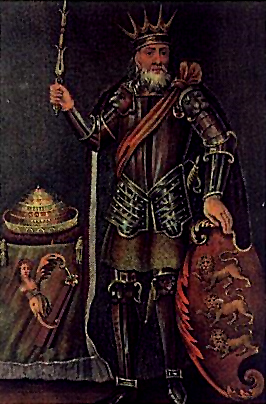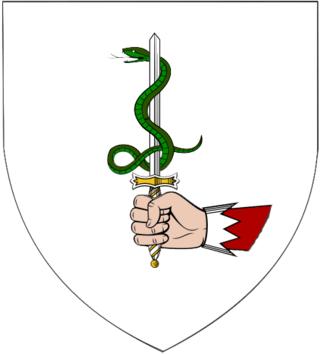There are four provinces of Ireland: Connacht, Leinster, Munster and Ulster. The Irish word for this territorial division, cúige, meaning "fifth part", suggests that there were once five, and at times Meath has been considered to be the fifth province. In the medieval period, however, there were often more than five. The number of provinces and their delimitation fluctuated until 1610, when they were permanently set by the English administration of James I. The provinces of Ireland no longer serve administrative or political purposes but function as historical and cultural entities.
This article concerns the Gaelic nobility of Ireland from ancient to modern times. It only partly overlaps with Chiefs of the Name because it excludes Scotland and other discussion. It is one of three groups of Irish nobility, the others being those nobles descended from the Hiberno-Normans and those granted titles of nobility in the Peerage of Ireland.

The Flight of the Earls took place in September 1607, when Hugh O'Neill, 2nd Earl of Tyrone, and Rory O'Donnell, 1st Earl of Tyrconnell, and about ninety followers, left Ulster in Ireland for mainland Europe. Their permanent exile was a watershed event in Irish history, symbolizing the end of the old Gaelic order.

High King of Ireland was a royal title in Gaelic Ireland held by those who had, or who are claimed to have had, lordship over all of Ireland. The title was held by historical kings and later sometimes assigned anachronously or to legendary figures.

The O'Donnell dynasty were the dominant Irish clan of the kingdom of Tyrconnell, Ulster, in medieval Ireland.

The Eóganachta or Eoghanachta were an Irish dynasty centred on Cashel which dominated southern Ireland from the 6/7th to the 10th centuries, and following that, in a restricted form, the Kingdom of Desmond, and its offshoot Carbery, to the late 16th century. By tradition the dynasty was founded by Conall Corc but named after his ancestor Éogan, the firstborn son of the semi-mythological 3rd-century king Ailill Aulom. This dynastic clan-name, for it was never in any sense a 'surname,' should more accurately be restricted to those branches of the royal house which descended from Conall Corc, who established Cashel as his royal seat in the late 5th century.
Earl of Tyrconnell is a title that has been created four times in the Peerage of Ireland.

Tyrconnell, also spelled Tirconnell, was a kingdom of Gaelic Ireland, associated geographically with present-day County Donegal, which has sometimes been called County Tyrconnell. At times it also included parts of County Fermanagh, County Sligo, County Leitrim, County Tyrone and County Londonderry at its greatest extent. The kingdom represented the core homeland of the Cenél Conaill people of the Northern Uí Néill and although they ruled, there were smaller groups of other Gaels in the area.
The kingdom of Uí Fháilghe, Uí Failge or Uíbh Fhailí was a Gaelic-Irish kingdom which existed to 1550, the name of which is preserved in the name of County Offaly, Ireland.
The Déisi were a social class in Ireland between the ancient and early medieval period. The various peoples listed under the heading déis shared a similar status in Gaelic Ireland, and had little or no actual kinship, though they were often thought of as genetically related. During the era of Roman rule in Britain, many members of the Déisi were recorded as settling in western coastal areas.

The Dalcassians are a Gaelic Irish clan, generally accepted by contemporary scholarship as being a branch of the Déisi Muman, that became very powerful in Ireland during the 10th century. Their genealogies claimed descent from Tál Cas. Their known ancestors are the subject of The Expulsion of the Déisi tale and one branch of their blood-line went on to rule the petty kingdom of Dyfed in Wales during the 4th century; probably in alliance with the Roman Emperor Magnus Maximus.
Cathal mac Finguine was an Irish King of Munster or Cashel, and effectively High King of Ireland as well. He belonged to the Eóganacht Glendamnach sept of the dominant Eóganachta kin-group whose members dominated Munster from the 7th century to the 10th. His father, uncle, grandfather and great-grandfather had also been kings of Cashel, as were his son and grandson.

Tír Eoghain, also known as Tyrone, was a kingdom and later earldom of Gaelic Ireland, comprising parts of present-day County Tyrone, County Armagh, County Londonderry and County Donegal (Raphoe). The kingdom represented the core homeland of the Cenél nEógain people of the Northern Uí Néill and although they ruled, there were smaller groups of other Gaels in the area. One part of the realm to the north-east broke away and expanded, becoming Clandeboye, ruled by a scion branch of the O'Neill dynasty. In one form or another, Tyrone existed for over a millennium. Its main capital was Dungannon, though kings were inaugurated at Tullyhogue Fort.

The O'Donovans are an Irish family. Their patronymic surname derives from Irish Ó Donnabháin, meaning the grandsons or descendants of Donnubán, referring to the 10th century ruler of the Uí Fidgenti, Donnubán mac Cathail. During the 12th and 13th century, O'Donovan relations relocated from the Bruree/Croom area south to the Kingdom of Desmond and to Carbery, where they were a ruling family for centuries and played a role in the establishment of a feudal society under the MacCarthys. Other septs retreated into the southeast corner of the Ui Fidgheinte territory, reaching from Broadford/Feenagh to the Doneraile area. The northern septs of the O'Donovans did not use a White Rod as the family's position in their original territory was vastly eroded, while several septs of O'Donovans in the southwest territories were semi-autonomous flatha under the MacCarthy Reagh dynasty in Carbery, with the most notable being local petty kings. The family were counted among the leading Gaelic nobility of Ireland.

The Uí Liatháin (IPA:[ˈiːˈlʲiəhaːnʲ]) were an early kingdom of Munster in southern Ireland. They belonged the same kindred as the Uí Fidgenti, and the two are considered together in the earliest sources, for example The Expulsion of the Déisi (incidentally). The two have been given various origins among both the early or proto-Eóganachta and among the Érainn or Dáirine by different scholars working in a number of traditions, with no agreement ever reached or appearing reachable. It is entirely possible that they were the product of a combination of lineages from both these royal kindreds, or alternatively of another origin entirely.
The Dáirine, later known dynastically as the Corcu Loígde and associated, were the proto-historical rulers of Munster before the rise of the Eóganachta in the 7th century AD. They were derived from or closely associated with the Darini of Ptolemy and were also related to the Ulaid and Dál Riata of Ulster and Scotland. Their ancestors appear frequently in the Ulster Cycle. In historical times the Dáirine were represented, as stated, by the Corcu Loígde, the Uí Fidgenti and Uí Liatháin, as well as a few other early historical kindreds of both Munster and Ulster. In ancient genealogical schemes, the historical Dál Fiatach of Ulaid also belong to the Dáirine.
The Corcu Loígde, meaning Gens of the Calf Goddess, also called the Síl Lugdach meic Itha, were a kingdom centred in West County Cork who descended from the proto-historical rulers of Munster, the Dáirine, of whom they were the central royal sept. They took their name from Lugaid Loígde "Lugaid of the Calf Goddess", a King of Tara and High King of Ireland, son of the great Dáire Doimthech. A descendant of Lugaid Loígde, and their most famous ancestor, is the legendary Lugaid Mac Con, who is listed in the Old Irish Baile Chuinn Chétchathaig. Closest kin to the Corcu Loígde were the Dál Fiatach princes of the Ulaid.

Historically, Fermanagh, as opposed to the modern County Fermanagh, was a kingdom of Gaelic Ireland, associated geographically with present-day County Fermanagh. Fir Manach originally referred to a distinct kin group of alleged Laigin origins. The kingdom of Fermanagh was formed in the 10th century, out of the larger kingdom of Uí Chremthainn, which was part of the overkingdom of Airgíalla. By the late 11th century it had grown to cover all of what is now County Fermanagh. The kingdom came to be ruled by the Mag Uidhir (Maguire) clan from the late 13th century onward. They were based at Lisnaskea, and their royal inauguration site was nearby Sgiath Gabhra (Skeagoura), now called Cornashee. Under Hugh Maguire, Fermanagh was involved in the Nine Years' War against English rule. His successor, Cú Chonnacht Óg Mag Uidhir, was one of the Gaelic Irish leaders who fled Ireland during the Flight of the Earls. Fermanagh was subsequently merged into the Kingdom of Ireland as County Fermanagh.
Éile, commonly anglicised as Ely, was a medieval petty kingdom in the southern part of the modern county of Offaly and parts of North Tipperary in Ireland. The historic barony of Eliogarty was once a significant portion of the kingdom.







